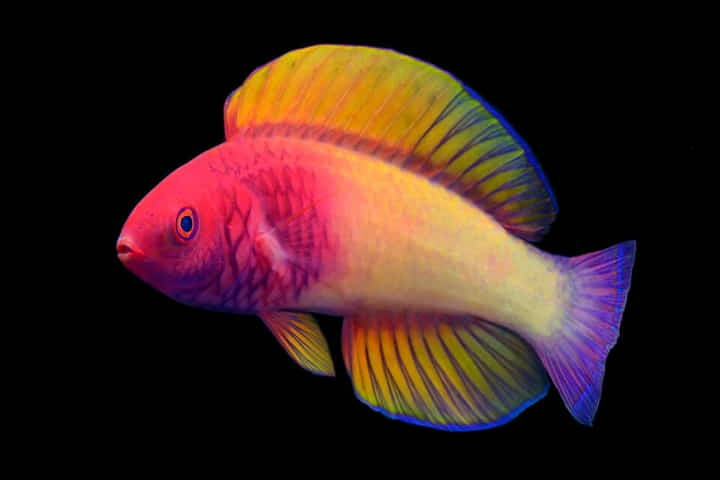

Christened rose-veiled fairy wrasse, this vibrant hued fish derives its name from Dhivehi language of Maldives (Pic. Courtesy Twitter/@MMRI_Maldives)
<p>
<strong>After having been confused with an existing species, the rose-veiled fairy wrasse found off the coast of the scenic Maldives islands, has been recognised as a separate genus. An article in smithsonianmag.com stated this fish which lives in the range from 131 to 229 feet below the surface has a vivid red-orange colour on its face which becomes yellow and violet when nearing the tail.</strong></p>
<p>
The waters around the islands of Maldives boasts of species in hundreds but what makes the rose-veiled fairy wrasse or Cirrhilabrus finifenmaa, special is the fact that it is the first one to be described by a Maldivian scientist and that it has the singular distinction of having a scientific name derived from Dhivehi, a local language.</p>
<p>
<iframe allow="accelerometer; autoplay; clipboard-write; encrypted-media; gyroscope; picture-in-picture" allowfullscreen="" frameborder="0" height="315" src="https://www.youtube.com/embed/gqHVmzV3gQE" title="YouTube video player" width="560"></iframe></p>
<p>
The species had to wait for a formal description and recognition as in the past it was mistaken for the red velvet fairy wrasse or Cirrhilabrus rubrisquamis.</p>
<p>
The details of this new species have been published in ZooKeys, a journal.</p>
<p>
<strong>Also read: <a href="https://www.indianarrative.com/science-news/new-genus-of-tarantula-hairy-spider-discovered-in-asia-after-years-156283.html">New genus of tarantula hairy spider discovered in Asia after 104 years!</a></strong></p>
<p>
It was in the 1990s that this colourful fish was spotted by marine biologists and because of the confusion with a species of fish its scientific description did not take place as per a statement by the California Academy of Sciences. The narrative of C. rubrisquamis&#39; the statement specified was on the basis of one juvenile specimen which had been collected in the Chagos Archipelago which is 621 miles south of the Maldives.</p>
<p>
Researchers face an uphill task while differentiating wrasse family fishes. The reason is that these brightly hued fish change their colours as they become adults. Therefore, it is common for the young ones of this group to appear like members of another group till such time the distinct features come into prominence in adulthood.</p>
<p>
It was on comparing the footage of adult wrasses of Maldives with that of Chagos did the idea of different species come to the scientists.</p>
<p>
Recalling the incident for CNN, the author of the study Luiz Rocha said: <a href="https://www.smithsonianmag.com/smart-news/new-vibrant-rainbow-colored-fairy-wrasse-officially-described-by-scientists-180979721/?utm_source=smithsoniandaily&amp;utm_medium=email&amp;utm_campaign=20220314-daily-responsive&amp;spMailingID=46541386&amp;spUserID=MTI4MDgxMTczNjcwMgS2&amp;spJobID=2201537188&amp;spReportId=MjIwMTUzNzE4OAS2" rel="nofollow">&quot;A few months ago, Yi-Kai Tea (our first author) received</a> (remotely operated vehicle) footage from Chagos showing adults, which were very different from the adults from the Maldives. That&#39;s when we decided that the species from the Maldives was new and different from C. rubrisquamis.&quot;</p>
<p>
Rocha is the California Academy of Science&rsquo;s fish scientist.</p>
<p>
With the aim of providing an accurate representation for the new species, the team of scientists from the California Academy of Sciences, the University of Sydney, the Maldives Marine Research Institute, and the Field Museum in Chicago did genetic analyses on both C. rubrisquamis and C. finifenmaa. This enabled them to confirm that the rose-veiled fairy wrasse was indeed a different species. Further, the differences between the grown-up and juveniles of this species were studied by spotting the patterns of the colours, counting of each scale and measuring the height of their spines.</p>
<p>
The fish&rsquo;s crimson colour got it the name finifenmaa, meaning rose in Dhivehi. Incidentally, the national flower of Maldives is rose.</p>
<p>
<strong>Also read: <a href="https://www.indianarrative.com/science-news/indian-researchers-reveal-the-hunting-secrets-of-the-elusive-fishing-cat-146017.html">Indian researchers reveal the hunting secrets of the elusive fishing cat</a></strong></p>
<p>
Eight other fish too were found by the divers, all of which may be new species. The expedition for finding new species and studying them and thereby protecting and restoring the fragile reef ecosystems world over, is part of the California Academy of Science&#39;s Hope for Reefs initiative.&nbsp;</p>
<p>
Quoting study author Ahmed Najeeb who is a biologist at the Maldives Marine Research Institute, the statement said: &quot;Our partnership will help us better understand the unexplored depths of our marine ecosystems and their inhabitants. The more we understand and the more compelling scientific evidence we can gather, the better we can protect them.&rdquo;</p>
India and the United States have stepped up their trade talks, with both sides actively…
Six crew members of the Liberian-flagged cargo ship 'Eternity C', which sank in the Red…
Brazilian President Luiz Inacio Lula da Silva on Wednesday (local time) issued a firm response…
An earthquake of magnitude 4.4 struck Jhajjhar district in Haryana on Thursday morning, according to…
Prime Minister Narendra Modi on Wednesday received a standing ovation and non-stop applause from lawmakers…
Hailing the relations between India and Africa, Prime Minister Narendra Modi stated that the ties…